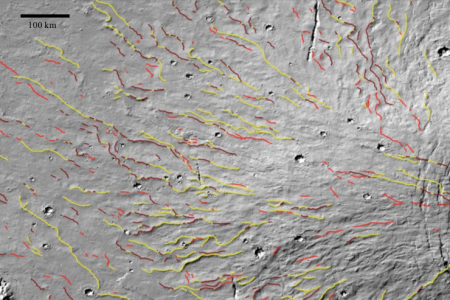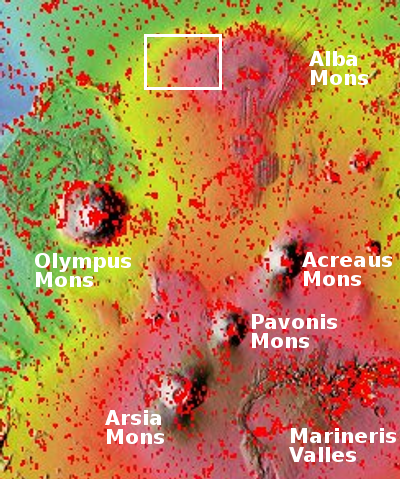Lava tubes on Alba Mons

During oral presentations today at this week’s 50th Lunar and Planetary Science Conference in Texas, scientists revealed [pdf] a map showing what they believe are numerous lava tubes flowing down the western slope of the giant Martian volcano Alba Mons.
The image on the right is taken from their paper. The red lines indicate collapsed tube sections, maroon collapsed sections on a ridge, and yellow volcanic ridges, which I assume are external surface flows. From their paper:
Lava tube systems … occur throughout the western flank, are concentrated in some locations, and are generally radial in orientation to Alba Mons’ summit. Lava tubes are typically discontinuous and delineated by sinuous chains of elongate depressions, which in many cases are located along the crests of prominent sinuous ridges. Lava tube systems occur as both these ridged forms with lateral flow textures and more subtle features denoted by a central distributary feature within the flat-lying flow field surface. Significant parts of the sinuous volcanic ridges show no collapse features, indicating a distinctive topographic signature for Alba Mons’ lava tubes.
Alba Mons is in some ways the forgotten giant volcano on Mars.

It is part of the same volcano region of all the giant volcanoes, sitting north of Olympus Mons and the more well-known chain of three volcanoes to Olympus Mons’ east. Unlike those volcanoes, Alba Mons is less distinct and thus not as dramatic. Instead of rising to a great height, it is spread over a much larger area, with a much more gentle slope on its flanks. The map to the right shows this region, with the location of the lava tube image above indicated by the white box.
These remnant tube sections suggest that the lava tubes flowing down from Alba Mons were quite long, far longer than anything found on Earth.
A total length of ~12,000 km [~7,500 miles] for 331 lava tube systems has been determined for the study region, with 47.3% defined by collapse features. Further mapping may link some of the currently mapped systems together, increasing maximum lengths from the current ~400 km [~250 miles] (and reducing the total number of lava tube systems). The currently mapped population of lava tube systems has a mean length of 36.2 km [22.5 miles], mean relief of 0.31 km, and mean surface slope of 0.51°
This research has only located tube sections that have either collapsed or are expressed as a ridgeline. It has not found any actual underground voids. However, I would suspect that many of the collapsed sections are connected with sections that remain unchanged and run for miles underground.
On Christmas Eve 1968 three Americans became the first humans to visit another world. What they did to celebrate was unexpected and profound, and will be remembered throughout all human history. Genesis: the Story of Apollo 8, Robert Zimmerman's classic history of humanity's first journey to another world, tells that story, and it is now available as both an ebook and an audiobook, both with a foreword by Valerie Anders and a new introduction by Robert Zimmerman.
The print edition can be purchased at Amazon or from any other book seller. If you want an autographed copy the price is $60 for the hardback and $45 for the paperback, plus $8 shipping for each. Go here for purchasing details. The ebook is available everywhere for $5.99 (before discount) at amazon, or direct from my ebook publisher, ebookit. If you buy it from ebookit you don't support the big tech companies and the author gets a bigger cut much sooner.
The audiobook is also available at all these vendors, and is also free with a 30-day trial membership to Audible.
"Not simply about one mission, [Genesis] is also the history of America's quest for the moon... Zimmerman has done a masterful job of tying disparate events together into a solid account of one of America's greatest human triumphs."--San Antonio Express-News

During oral presentations today at this week’s 50th Lunar and Planetary Science Conference in Texas, scientists revealed [pdf] a map showing what they believe are numerous lava tubes flowing down the western slope of the giant Martian volcano Alba Mons.
The image on the right is taken from their paper. The red lines indicate collapsed tube sections, maroon collapsed sections on a ridge, and yellow volcanic ridges, which I assume are external surface flows. From their paper:
Lava tube systems … occur throughout the western flank, are concentrated in some locations, and are generally radial in orientation to Alba Mons’ summit. Lava tubes are typically discontinuous and delineated by sinuous chains of elongate depressions, which in many cases are located along the crests of prominent sinuous ridges. Lava tube systems occur as both these ridged forms with lateral flow textures and more subtle features denoted by a central distributary feature within the flat-lying flow field surface. Significant parts of the sinuous volcanic ridges show no collapse features, indicating a distinctive topographic signature for Alba Mons’ lava tubes.
Alba Mons is in some ways the forgotten giant volcano on Mars.

It is part of the same volcano region of all the giant volcanoes, sitting north of Olympus Mons and the more well-known chain of three volcanoes to Olympus Mons’ east. Unlike those volcanoes, Alba Mons is less distinct and thus not as dramatic. Instead of rising to a great height, it is spread over a much larger area, with a much more gentle slope on its flanks. The map to the right shows this region, with the location of the lava tube image above indicated by the white box.
These remnant tube sections suggest that the lava tubes flowing down from Alba Mons were quite long, far longer than anything found on Earth.
A total length of ~12,000 km [~7,500 miles] for 331 lava tube systems has been determined for the study region, with 47.3% defined by collapse features. Further mapping may link some of the currently mapped systems together, increasing maximum lengths from the current ~400 km [~250 miles] (and reducing the total number of lava tube systems). The currently mapped population of lava tube systems has a mean length of 36.2 km [22.5 miles], mean relief of 0.31 km, and mean surface slope of 0.51°
This research has only located tube sections that have either collapsed or are expressed as a ridgeline. It has not found any actual underground voids. However, I would suspect that many of the collapsed sections are connected with sections that remain unchanged and run for miles underground.
On Christmas Eve 1968 three Americans became the first humans to visit another world. What they did to celebrate was unexpected and profound, and will be remembered throughout all human history. Genesis: the Story of Apollo 8, Robert Zimmerman's classic history of humanity's first journey to another world, tells that story, and it is now available as both an ebook and an audiobook, both with a foreword by Valerie Anders and a new introduction by Robert Zimmerman.
The print edition can be purchased at Amazon or from any other book seller. If you want an autographed copy the price is $60 for the hardback and $45 for the paperback, plus $8 shipping for each. Go here for purchasing details. The ebook is available everywhere for $5.99 (before discount) at amazon, or direct from my ebook publisher, ebookit. If you buy it from ebookit you don't support the big tech companies and the author gets a bigger cut much sooner.
The audiobook is also available at all these vendors, and is also free with a 30-day trial membership to Audible.
"Not simply about one mission, [Genesis] is also the history of America's quest for the moon... Zimmerman has done a masterful job of tying disparate events together into a solid account of one of America's greatest human triumphs."--San Antonio Express-News


These are surface lava tubes, the mountain is probably honeycombed miles deep with more tubes that were covered by lava flow and forgotten. A future metroplex housing millions of colonist, farms, animals with room to grow.